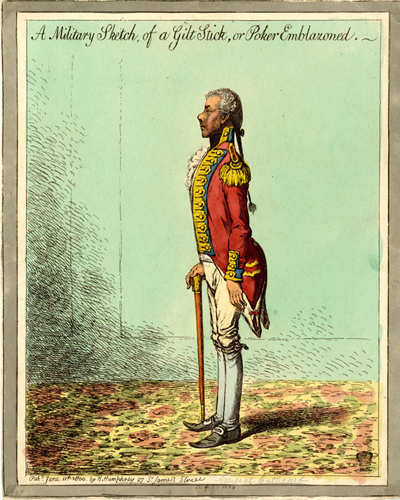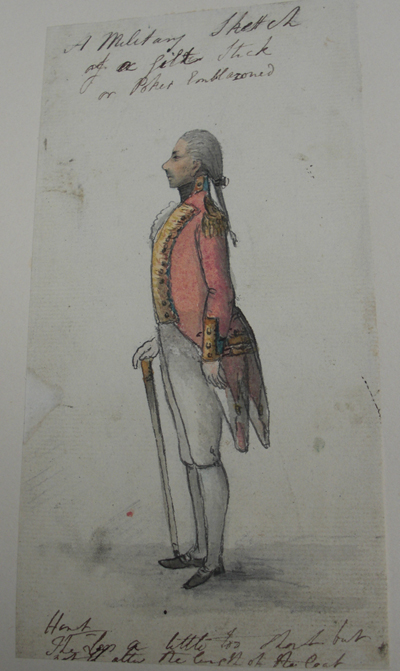A Military Sketch of a Gilt Stick, or Poker Emblazoned
This is a traditional portrait caricature of William Cathcart, 1st Earl Cathcart. As usual in portrait caricatures, Cathcart is seen in profile against a nearly blank background and identified, but not named, by the descriptive title.

© Trustees of the British Museum
The "Gilt Stick" refers to the honorary position of Gold Stick, i.e. bodyguard to the sovereign, symbolized by a gold-tipped staff of office which Cathcart holds in his right hand. The position is typically given jointly to Colonels of the Regiment of Life Guards and Blues and Royals. Cathcart had been promoted to Colonel of the Life Guards in August 1797, and is officially mentioned as Gold Stick in Waiting (on duty) in the November 19, 1797 edition of the London Observer. His firmly erect stance and slightly swarthy face may explain his description as a "poker" now "emblazoned" (celebrated or publicly extolled) by being named Gold Stick.
The print is based upon a drawing in the British Museum by a currently unnamed amateur, so we can see what Gillray started with and the changes that he made. In general, Gillray stays faithful to his source, and even heeds the "Hint" provided by the amateur artist: "The legs a little too short but not to alter the length of the coat." But we can also see that Gillray sharpens and improves it in every way. The face has more contour, the buttons of his coat and the epaulet on his shoulder are better defined, his breeches and legs have more detail and better depth, and his coat tails hang more naturally.

Photo by Jim Sherry
© Trustees of the British Museum
The title of both print and drawing suggest that the "Sketch" is not only of a military man, but also by a military man. Ever since George Townshend in the 1750s, members of the military with mapping and drawing skills had been indulging in caricature. So it wouldn't be surprising if the "Military Sketch" of Cathcart were created by another officer and colleague. And in this case, I think we can hazard a reasonable guess at his identity.
According to Alexander Meyrick Broadley in Napoleon in Caricature 1795 - 1821 (p. 49), the 24 year old Thomas Braddyll was a Lieutenant of the the Coldstream Guards in 1800. This would have been at the same time that Cathcart was a Lieutenant-Colonel in the same regiment, so it is very likely that Braddyll would have had the opportunity to meet or at least see Cathcart. Braddyll was an amateur caricaturist and has long been credited with providing drawings for a number of later Gillray prints, including the two plates of The King of Brobdingnag and Gulliver (1803 and 1804), St. George and the Dragon (1805), and Farmer Giles & his Wife Shewing Off their Daughter Betty to their Neighbours (1809). If you compare the sketching and writing style of the known Braddyll drawings with the present drawing of A Military Sketch of a Gilt Stick, however, I think it's quite clear that this too must have been created by Braddyll. If I am correct, it suggests an earlier connection with Braddyll than previously recognized.
Sources and Reading
- Commentary from the British Museum on A Military Sketch of a Gilt Stick, or Poker Emblazoned.
- "William Cathcart, 1st Earl Cathcart," Wikipedia
- "Gold Stick and Silver Stick," Wikipedia
- Thomas Wright and R.H. Evans, Historical and Descriptive Account of the Caricatures of James Gillray #460
- Thomas Wright and Joseph Grego, The Works of James Gillray, the Caricaturist; With the History of His Life and Times p. 271
Comments & Corrections
NOTE: Comments and/or corrections are always appreciated. To make that easier, I have included a form below that you can use. I promise never to share any of the info provided without your express permission.